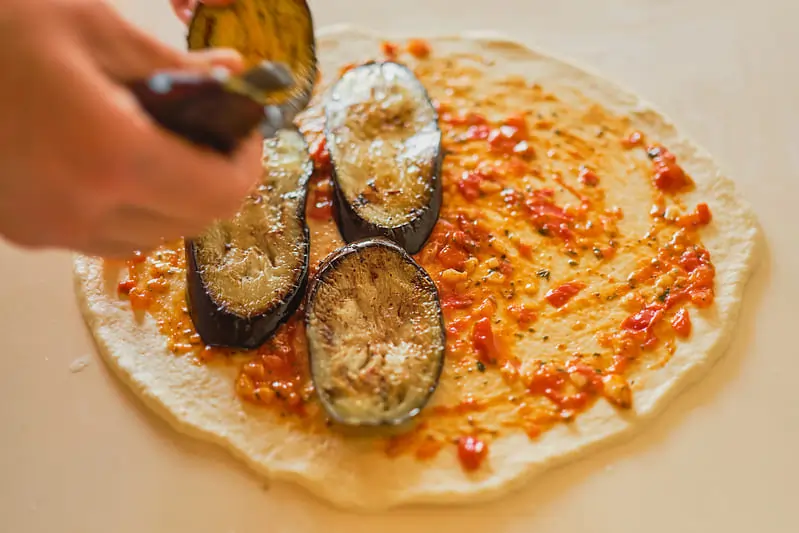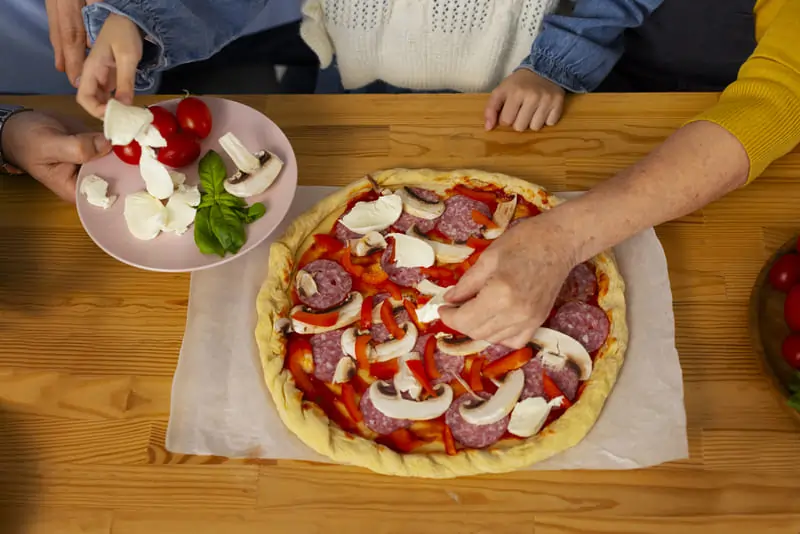Pizza is a versatile dish that has evolved in countless ways to cater to a wide range of taste buds. One of the most intriguing variations is pickle pie pizza, a delightful fusion of tangy pickles, creamy sauces, and melted cheese. This unconventional pizza flavor has taken foodies by storm and is a must-try for adventurous eaters. Let’s dive into the origins, ingredients, and how you can create this unique pizza at home.
What Is Pickle Pie Pizza?
Pickle pie pizza combines the classic elements of pizza with the unexpected tangy kick of pickles. The pizza typically features a creamy ranch or garlic-based sauce, mozzarella cheese, and sliced pickles, finished with dill or other spices. Its balance of tangy, creamy, and cheesy flavors has made it a viral sensation.
Originating from pizzerias like Ann Kim’s Pizzeria Lola, pickle pie pizza has quickly become a trendy choice for those seeking bold flavors. To learn more about creating distinctive and bold dishes, check out what are the correct layers for lasagna.
The Ingredients That Make Pickle Pie Pizza Special
Pickle pie pizza has gained popularity for its bold and unique flavor combination, where each ingredient contributes to its deliciousness. Here’s a detailed breakdown of the key components and how they come together to create this crowd-pleasing dish:
1. The Crust
The crust serves as the foundation of pickle pie pizza, and choosing the right base is crucial. Thin crust is a classic option, offering a crispy texture that complements the toppings without overpowering them. For a slightly more decadent approach, puff pastry can be used, providing a light, buttery, and flaky base that enhances the overall flavor profile. Whichever crust you choose, pre-baking it slightly ensures a crisp finish that holds up well under the toppings.
2. The Sauce
Instead of traditional tomato-based pizza sauce, pickle pie pizza uses creamy sauces to elevate the tangy flavor of pickles. Ranch dressing is a favorite, offering a zesty and herbaceous backdrop, while garlic aioli adds richness and a subtle kick of garlic. For a lighter variation, consider blending Greek yogurt with dill and lemon juice to create a tangy yet refreshing alternative.
For tips on balancing moisture in sauces, explore this guide on achieving the perfect sauce consistency.
3. The Cheese
The choice of cheese plays a significant role in achieving the perfect balance of creaminess and flavor. Mozzarella is a go-to for its mild taste and excellent melting qualities. For added depth, pair it with parmesan or fontina, both of which bring a slightly nutty and buttery flavor. Combining cheeses can create a layered, complex taste that perfectly complements the pickles. Shred the cheese fresh for the best melting and texture.
4. The Pickles
Pickles are, of course, the star of the show. Dill pickles are the most common choice, lending a tangy, briny flavor that pairs beautifully with the creamy sauce and cheese. For a twist, try bread-and-butter pickles for a touch of sweetness or spicy pickles to add heat. Slice them thinly and pat them dry to prevent excess moisture from soaking the crust during baking.
5. The Seasonings
The right seasonings can elevate the flavors of pickle pie pizza, adding complexity and enhancing the overall experience. Fresh or dried dill amplifies the pickle’s tanginess, while red pepper flakes bring a touch of heat. For a sweet-savory balance, drizzle hot honey over the baked pizza—this contrast creates an exciting flavor profile. Cracked black pepper and a sprinkle of garlic powder can also add subtle yet essential notes.
For more ideas on unique flavor pairings, check out this guide to creative ingredient combinations.
By carefully selecting and preparing each ingredient, you can create a pickle pie pizza that is both unique and irresistible. Whether you stick with classic dill pickles or experiment with spicy or sweet variations, this pizza is a guaranteed hit for anyone looking to try something out of the ordinary.
Why Pickle Pie Pizza Works

Pickle pie pizza has gained attention for its innovative combination of flavors and textures, creating a truly unique culinary experience. Its popularity can be attributed to how well the ingredients complement one another, resulting in a balanced and satisfying dish. Here’s a deeper dive into why pickle pie pizza is such a hit:
1. Tangy and Creamy Contrast
The sharp tanginess of pickles serves as the star flavor, providing a bright, briny kick that immediately captures the palate. This bold tang pairs exceptionally well with the creamy richness of the sauce, whether it’s ranch dressing or garlic aioli. The creaminess mellows out the pickle’s acidity, creating a harmonious contrast that’s both refreshing and indulgent. For an added layer of complexity, try experimenting with sauces like a dill-infused Greek yogurt or a lemon-garlic béchamel.
For more insights into achieving flavor harmony, explore this guide to balancing flavors in creative recipes.
2. Textural Variety
Pickle pie pizza is a textural masterpiece. The thinly sliced pickles bring a satisfying crunch that contrasts beautifully with the soft, gooey melted cheese. Meanwhile, the crust—whether thin and crispy or buttery and flaky—adds another layer of texture, tying the whole dish together. This interplay between crunchy, creamy, and crisp textures keeps every bite interesting and enjoyable, making it a sensory delight for the mouth.
3. Unique Flavor Profile
What truly sets pickle pie pizza apart is its one-of-a-kind flavor profile. The dill seasoning accentuates the pickles’ natural tanginess, while the optional addition of hot honey introduces a sweet-spicy element that elevates the dish to gourmet status. This combination of tangy, creamy, and slightly sweet flavors creates a memorable pizza that stands out from traditional options. Adding red pepper flakes or a touch of garlic powder can further deepen the layers of flavor, catering to those who enjoy a bit of heat or savoriness.
Enhancing the Experience
To enhance the flavor and texture of pickle pie pizza even further, consider these tips:
- Use High-Quality Ingredients: Opt for fresh dill pickles, artisanal cheeses, and a well-prepared crust to ensure every component shines.
- Experiment with Toppings: Try adding caramelized onions, a sprinkle of parmesan, or even thin slices of crispy bacon for an extra burst of flavor.
- Play with Sweet and Savory: Drizzle hot honey or balsamic glaze after baking to balance the tanginess of the pickles with a touch of sweetness.
For inspiration on how flavor balance works in other dishes, take a look at this easy 4-ingredient banana bread recipe. Understanding how simple ingredients interact can help you appreciate the magic of pickle pie pizza even more.
Pickle pie pizza works because it dares to be different while mastering the fundamentals of flavor and texture. The interplay of tangy pickles, creamy sauce, gooey cheese, and a crispy crust makes it an exciting choice for adventurous eaters and pizza lovers alike.
How to Make Pickle Pie Pizza at Home

Crafting a delicious pickle pie pizza at home is both simple and rewarding. This recipe balances tangy, creamy, and savory flavors with an easy step-by-step process that even novice cooks can follow. Here’s a detailed guide to help you create this unique dish.
Ingredients
To make pickle pie pizza, you’ll need the following:
- 1 pizza crust: Opt for a thin crust for crispness or puff pastry for a buttery, flaky base.
- ½ cup ranch dressing or garlic aioli: This serves as the creamy sauce foundation.
- 1 cup shredded mozzarella cheese: Provides the gooey, melty texture that holds the toppings together.
- ½ cup sliced dill pickles: The star ingredient, offering a tangy bite.
- 1 tsp dill seasoning: Enhances the pickles’ flavor and adds a fresh herbal note.
- Optional toppings: Red pepper flakes for heat or hot honey for a sweet-spicy twist.
Instructions
Step 1: Preheat the Oven
Set your oven to 450°F (232°C). Preheating ensures the crust cooks evenly and achieves a perfect crispness. For puff pastry, you may need to reduce the heat slightly or monitor closely, as it can brown quickly.
Step 2: Prepare the Crust
Roll out the pizza crust on a baking sheet or pizza stone. If using puff pastry, prick the surface lightly with a fork to prevent excessive puffing during baking.
Step 3: Add the Sauce
Spread the ranch dressing or garlic aioli evenly over the crust, ensuring full coverage to prevent dry spots. For a tangier option, mix a small amount of dill pickle brine into the sauce before spreading.
Step 4: Layer the Cheese
Sprinkle the shredded mozzarella cheese over the sauce. To elevate the flavor, consider adding a small amount of parmesan or fontina for a richer cheese profile.
Step 5: Add the Pickles
Arrange the sliced pickles evenly across the pizza. Thin slices work best, as they distribute flavor without overwhelming the dish. Pat the pickles dry with a paper towel before adding them to prevent excess moisture that could make the crust soggy.
Step 6: Season and Optional Toppings
Sprinkle dill seasoning over the pickles to enhance their herbal notes. If you enjoy heat, add a pinch of red pepper flakes for a spicy kick.
Step 7: Bake the Pizza
Place the pizza in the preheated oven and bake for 12–15 minutes. Watch for the crust to turn golden and the cheese to bubble. Puff pastry may require slightly less baking time, so keep an eye on it to avoid burning.
Step 8: Add Final Touches
Once out of the oven, drizzle hot honey over the pizza for a sweet and spicy twist. This step adds a layer of complexity that perfectly balances the tangy and creamy elements. Alternatively, sprinkle fresh herbs like parsley or chives for a fresh finish.
Additional Tips
- Crust Options: If you prefer a softer base, use pre-made pizza dough or naan bread as an alternative to traditional crusts.
- Cheese Variations: Experiment with cheese combinations, such as cheddar or gouda, to create a personalized flavor profile.
- Pickle Choices: Swap dill pickles for bread-and-butter or spicy pickles to suit your taste preferences.
For more advice on baking techniques and ensuring your pizza turns out perfect every time, explore this guide on whether to bake lasagna covered or uncovered. Understanding how to manage moisture and baking conditions can be applied to pizza-making as well.
Variations of Pickle Pie Pizza
While the classic recipe is a crowd-pleaser, here are some creative twists:
- Vegetarian Delight: Add mushrooms, spinach, or roasted peppers for extra flavor.
- Spicy Pickle Pizza: Incorporate jalapeños and a drizzle of hot sauce for a fiery kick.
- Gourmet Pickle Pizza: Use smoked onions, charred crusts, or artisan cheeses like gouda or gruyere.
Frequently Asked Questions About Pickle Pie Pizza
What does pickle pie pizza taste like?
It’s tangy, creamy, and slightly salty, with a hint of dill and a rich cheese flavor.
Can I use homemade pickles?
Yes, homemade pickles can add a fresh and customized taste to your pizza.
What cheese pairs best with pickles on pizza?
Mozzarella, parmesan, and fontina are popular choices for their mild and creamy profiles.
Can I make pickle pie pizza without ranch sauce?
Absolutely! Garlic butter or béchamel sauce are excellent alternatives.
Is pickle pie pizza served hot or cold?
It’s typically served hot, but it can also be enjoyed cold as leftovers.
For additional FAQs about unique pizza recipes, visit is Barilla lasagna good?.
Why You Should Try Pickle Pie Pizza
Pickle pie pizza offers a bold, tangy twist on the classic pizza formula. Its unique combination of flavors is a treat for pickle enthusiasts and a delightful surprise for skeptics. Whether you’re making it at home or ordering from a local pizzeria, it’s a must-try for anyone seeking a creative culinary experience.
Start exploring more creative recipes like this with Ann Kim’s famous pickle pizza recipe.

